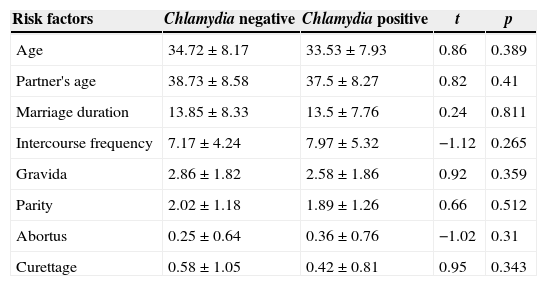The most common sexually transmitted disease (STD) is caused by Chlamydia trachomatis. Screening of different populations of women have shown prevalence rates of C. trachomatis of 1–25%.1C. trachomatis infections were associated with mucopurulent, cervicitis, endometritis, pelvic inflammatory disease (PID), salpingitis, postabortal pelvic sepsis and perihepatitis and long-term complications of PID, infertility and ectopic pregnancy.2
Several risk factors were reported to be associated with C. trachomatis infections such as: age, sex, family status, education, ethnic status, initial age of sexual activity, number of sexual partners, oral contraceptives, or an intrauterine device, smoking, drug addiction had been reported as risk factors of infections.3
The women who were admitted to Family Planning Department during the period from March 2003 to August 2004 were included in this study. In our study enrolment criteria were age older than 17 years; no previous history of gynecological operation. The patients who fulfilled the criteria were included in the study.
Prior to enrollment, in the study, an informed consent was obtained from the patients and the study was approved by local ethical committee. All the patients were face to face interviewed and cervical smears and swabs for Chlamydial DNA study were obtained from all cases. Data were expressed as mean standard deviation and SPSS statistical software package (SPSS, version 12 for Windows; SPSS Inc., Chicago, IL, USA) was used for statistical analyses.
The mean age of 1353 cases was 34.69±8.16 years (ranging from 17 to 73 years). The overall Chlamydial-DNA positivity was 2.66% (36 cases) for C. trachomatis. Age, partner's age (p=0.38), marriage duration (p=0.81), frequency of sexual intercourse (p=0.26), number of birth (p=0.36), parity (p=0.51), history of abortion (p=0.31) and curettage (p=0.34) revealed no statistically significant difference between the Chlamydia polymerase chain reaction (PCR) positive and negative groups (Table 1). Presence of pathologic vaginal discharge and vaginal pH were not statistically associated with Chlamydial positivity.
Risk factors for Chlamydia infections.
| Risk factors | Chlamydia negative | Chlamydia positive | t | p |
|---|---|---|---|---|
| Age | 34.72±8.17 | 33.53±7.93 | 0.86 | 0.389 |
| Partner's age | 38.73±8.58 | 37.5±8.27 | 0.82 | 0.41 |
| Marriage duration | 13.85±8.33 | 13.5±7.76 | 0.24 | 0.811 |
| Intercourse frequency | 7.17±4.24 | 7.97±5.32 | −1.12 | 0.265 |
| Gravida | 2.86±1.82 | 2.58±1.86 | 0.92 | 0.359 |
| Parity | 2.02±1.18 | 1.89±1.26 | 0.66 | 0.512 |
| Abortus | 0.25±0.64 | 0.36±0.76 | −1.02 | 0.31 |
| Curettage | 0.58±1.05 | 0.42±0.81 | 0.95 | 0.343 |
| Number of persons | Percent | Number of cases | Percent | ||
|---|---|---|---|---|---|
| Number of marriages | |||||
| 0 | 12 | 0.9 | 2 | 5.6 | |
| 1 | 1292 | 98.1 | 32 | 88.9 | y2: 14.20 |
| 2 | 13 | 1.0 | 2 | 5.6 | p=0.001 |
| Number of partners | |||||
| 0 | 25 | 1.9 | 0.0 | ||
| 1 | 1288 | 97.8 | 36 | 100.0 | x2: 0.81 |
| 2 | 4 | 0.3 | 0.0 | p=0.667 | |
The rate of Chlamydia DNA positivity was 2.6% in our study which was relatively low compared to the Turkish data.4 Studies from different geographic regions of world reported different ratios such as ranging from 0.8 to 14%.5 In addition to age, different from the literature, the partner's age, marriage duration, frequency of sexual intercourse, contraception method use, occupation of the cases and their partners together with the educational levels of cases, number of gravida, parity, abortion and curettage of the cases revealed no statistically significant difference between the Chlamydia positive and negative groups.
In conclusion, in our study Chlamydia prevalence of Turkish population was found to be similar to other countries. Regarding its high risk of developing sequela; effective screening programmes for Chlamydia infections and their long term adverse effects such as PID; ectopic pregnancy, infertility are essential.
Conflict of interestThe authors have no conflict of interest to declare.





